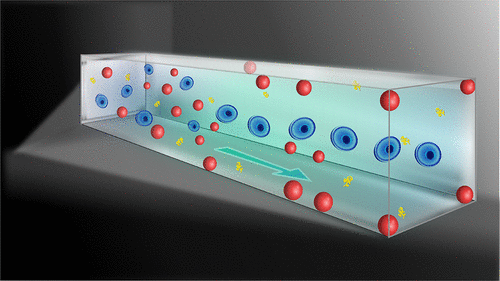当前位置:
X-MOL 学术
›
Anal. Chem.
›
论文详情
Our official English website, www.x-mol.net, welcomes your
feedback! (Note: you will need to create a separate account there.)
“From the Edge to the Center”: Viscoelastic Migration of Particles and Cells in a Strongly Shear-Thinning Liquid Flowing in a Microchannel
Analytical Chemistry ( IF 6.7 ) Pub Date : 2017-11-10 00:00:00 , DOI: 10.1021/acs.analchem.7b02450 Francesco Del Giudice 1, 2 , Shivani Sathish 1 , Gaetano D’Avino 3 , Amy Q. Shen 1
Analytical Chemistry ( IF 6.7 ) Pub Date : 2017-11-10 00:00:00 , DOI: 10.1021/acs.analchem.7b02450 Francesco Del Giudice 1, 2 , Shivani Sathish 1 , Gaetano D’Avino 3 , Amy Q. Shen 1
Affiliation

|
Controlling the fate of particles and cells in microfluidic devices is critical in many biomedical applications, such as particle and cell alignment and separation. Recently, viscoelastic polymer solutions have been successfully used to promote transversal migration of particles and cells toward fixed positions in straight microchannels. When inertia is negligible, numerical simulations have shown that strongly shear-thinning polymer solutions (fluids with a shear viscosity that decreases with increasing flow rates) promote transversal migration of particles and cells toward the corners or toward the centerline in a straight microchannel with a square cross section, as a function of particle size, cell deformability, and channel height. However, no experimental evidence of such shifting in the positions for particles or cells suspended in strongly shear-thinning liquids has been presented so far. In this work, we demonstrate that particle positions over the channel cross section can be shifted “from the edge to the center” in a strongly shear-thinning liquid. We investigate the viscoelasticity-induced migration of both rigid particles and living cells (Jurkat cells and NIH 3T3 fibroblasts) in an aqueous 0.8 wt % hyaluronic acid solution. The combined effect of fluid elasticity, shear-thinning, geometric confinement, and cell deformability on the distribution of the particle/cell positions over the channel cross section is presented and discussed. In the same shear-thinning liquid, separation of 10 and 20 μm particles is also achieved in a straight microchannel with an abrupt expansion. Our results envisage further applications in viscoelasticity-based microfluidics, such as deformability-based cell separation and viscoelastic spacing of particles/cells.
中文翻译:

“从边缘到中心”:在微通道中强烈剪切稀化的液体中,颗粒和细胞的粘弹性迁移
在许多生物医学应用中,例如微颗粒和细胞的排列和分离,控制微流体装置中的颗粒和细胞的命运至关重要。最近,粘弹性聚合物溶液已成功用于促进颗粒和细胞向直线微通道中固定位置的横向迁移。当惯性可忽略不计时,数值模拟表明,强烈剪切稀化的聚合物溶液(剪切粘度随流速的增加而降低的流体)会促进颗粒和细胞在具有正方形的笔直微通道中向角或中心线的横向迁移。横截面随粒径,细胞变形性和通道高度的变化而变化。然而,迄今为止,还没有实验证据表明悬浮在强烈剪切稀薄的液体中的颗粒或细胞的位置发生这种变化。在这项工作中,我们证明了在强剪切稀化液体中,通道横截面上的粒子位置可以“从边缘到中心”移动。我们研究了在0.8 wt%透明质酸水溶液中由粘弹性诱导的刚性颗粒和活细胞(Jurkat细胞和NIH 3T3成纤维细胞)的迁移。提出并讨论了流体弹性,剪切稀化,几何限制和单元变形能力对通道截面上的粒子/单元位置分布的综合影响。在相同的剪切稀化液体中,还可以在具有突然膨胀的笔直微通道中分离10和20μm的颗粒。
更新日期:2017-11-11
中文翻译:

“从边缘到中心”:在微通道中强烈剪切稀化的液体中,颗粒和细胞的粘弹性迁移
在许多生物医学应用中,例如微颗粒和细胞的排列和分离,控制微流体装置中的颗粒和细胞的命运至关重要。最近,粘弹性聚合物溶液已成功用于促进颗粒和细胞向直线微通道中固定位置的横向迁移。当惯性可忽略不计时,数值模拟表明,强烈剪切稀化的聚合物溶液(剪切粘度随流速的增加而降低的流体)会促进颗粒和细胞在具有正方形的笔直微通道中向角或中心线的横向迁移。横截面随粒径,细胞变形性和通道高度的变化而变化。然而,迄今为止,还没有实验证据表明悬浮在强烈剪切稀薄的液体中的颗粒或细胞的位置发生这种变化。在这项工作中,我们证明了在强剪切稀化液体中,通道横截面上的粒子位置可以“从边缘到中心”移动。我们研究了在0.8 wt%透明质酸水溶液中由粘弹性诱导的刚性颗粒和活细胞(Jurkat细胞和NIH 3T3成纤维细胞)的迁移。提出并讨论了流体弹性,剪切稀化,几何限制和单元变形能力对通道截面上的粒子/单元位置分布的综合影响。在相同的剪切稀化液体中,还可以在具有突然膨胀的笔直微通道中分离10和20μm的颗粒。









































 京公网安备 11010802027423号
京公网安备 11010802027423号